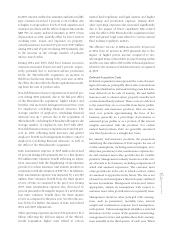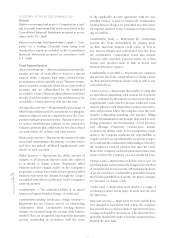American Express 2004 Annual Report Download - page 64
Download and view the complete annual report
Please find page 64 of the 2004 American Express annual report below. You can navigate through the pages in the report by either clicking on the pages listed below, or by using the keyword search tool below to find specific information within the annual report.
2004 and 2003, respectively, of below investment grade
securities (excluding net unrealized appreciation and
depreciation), which were recorded as a result of the
December 31, 2003 adoption of FIN 46. These assets
are not available for AEFA’s general use as they are for
the benefit of the CDO debt holders and reductions in
values of such investments will be fully absorbed by the
third party investors. Excluding the impact of FIN 46,
investments include $2.9 billion at both December 31,
2004 and 2003 of below investment grade securities
(excluding net unrealized appreciation and deprecia-
tion), representing 7 percent of AEFA’s investment
portfolio, and non-performing assets relative to
invested assets (excluding short-term cash positions)
were less than 0.01% at both December 31, 2004
and 2003.
Assets consolidated as a result of the December 31,
2003 adoption of FIN 46 were $1.2 billion. The newly
consolidated assets consisted of $844 million of cash,
$244 million of below investment grade securities
classified as Available-for-Sale (including net unreal-
ized appreciation and depreciation), $64 million of
derivatives and $15 million of loans and other assets,
essentially all of which are restricted. The effect of con-
solidating these assets on AEFA’s balance sheet was off-
set by AEFA’s previously recorded carrying values of its
investment in such structures, which totaled $673 mil-
lion. The Company also recorded $500 million of newly
consolidated liabilities, which consisted of $325 million
of non-recourse debt, $175 million of other liabilities
and $9 million of net unrealized after-tax appreciation
on securities classified as Available-for-Sale.
The consolidation of FIN 46-related entities resulted in
a cumulative effect of accounting change that reduced
2003 net income through a non-cash charge of $13 mil-
lion ($20 million pretax). The net charge was com-
prised of a $57 million ($88 million pretax) non-cash
charge related to the consolidated CDO offset by a
$44 million ($68 million pretax) non-cash gain related
to the consolidated SLTs. One of the three SLTs
originally consolidated was liquidated in 2004 and the
other two are in the process of being liquidated as of
December 31, 2004.
The initial charge related to the application of FIN 46
for the CDO and SLTs had no cash flow effect on the
Company. Ongoing valuation adjustments specifically
related to the application of FIN 46 to the CDO are also
non-cash items and will be reflected in the Company’s
quarterly results until maturity. These ongoing valua-
tion adjustments, which will be reflected in operating
results over the remaining lives of the structure subject
to FIN 46 and which will be dependent upon market
factors during such time, will result in periodic gains
and losses. In the aggregate, such gains or losses
related to the CDO, including the December 31, 2003
implementation charge, will reverse themselves over
time as the structure matures, because the debt issued
to the investors in the CDO is non-recourse to the Com-
pany, and further reductions in the value of the related
assets will ultimately be absorbed by the third-party
investors. Therefore, the Company’s maximum cumu-
lative exposure to pretax loss as a result of its invest-
ment in the CDO is represented by the carrying value
prior to the adoption of FIN 46, which was nil. The
expected impact related to the liquidation of the two
remaining SLTs is $4 million and has been included in
2004 results of operations. However, further adjust-
ments to that amount could occur based on market
movements and execution of the liquidation process.
To the extent further adjustments are incurred in the
liquidation of the remaining SLT portfolios, the Com-
pany’s maximum cumulative exposure to pretax loss is
represented by the pretax net assets, which is $462 mil-
lion at December 31, 2004.
As of December 31, 2004, AEFA continued to hold
investments in CDOs managed by AEFA that were not
consolidated pursuant to the adoption of FIN 46 as the
Company was not considered the primary beneficiary.
As a condition to its managing certain CDOs, AEFA is
generally required to invest in the residual or “equity”
tranche of the CDO, which is typically the most subor-
dinated tranche of securities issued by the CDO entity.
AEFA’s exposure as an investor is limited solely to its
aggregate investment in the CDOs, and it has no obli-
gations or commitments, contingent or otherwise, that
could require any further funding of such investments.
As of December 31, 2004, the carrying values of the
CDO residual tranches managed by AEFA were $27 mil-
lion. AEFA also has a retained interest in a CDO-related
securitization trust with a carrying value of $705 mil-
lion, of which $523 million is considered investment
grade. One of the results of this transaction is that
increases and decreases in future cash flows of the indi-
vidual CDOs are combined into one overall cash flow
for purposes of determining the carrying value of the
retained interests and related impact on results of
operations. CDOs are illiquid investments. As an inves-
tor in the residual tranche of CDOs, AEFA’s return
correlates to the performance of portfolios of high-
yield bonds and/or bank loans comprising the CDOs.
AXP
AR.04
62
Financial Review
























